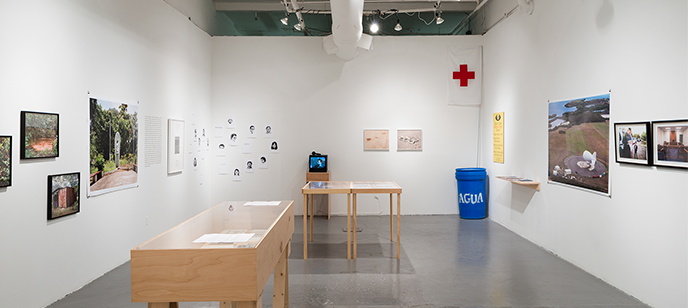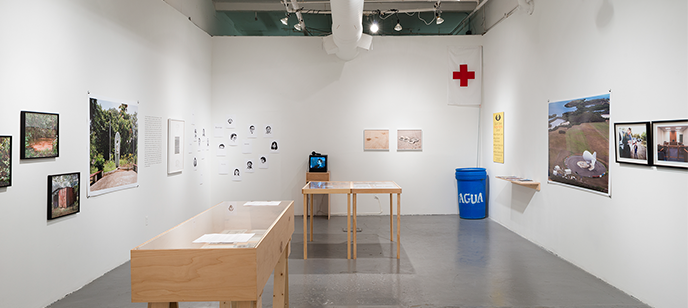
On Friday August 26, the art exhibition Borderland Collective: Northern Triangle opened at the Krannert Art Museum. The exhibition provides plenty of material for a dialogue about the issues of migration and human rights, but navigating the renovation and exhibit itself may prove daunting for some.
Organized by the Borderland Collective and the Blue Star Contemporary of Austin San Antonio, TX, Borderland Collective: Northern Triangle aims to tackle the subject of the Northern Triangle and its larger historical context through artistic interpretations and other ephemera. The Northern Triangle is the name for the region of migration routes to the United States through Mexico from Central American countries El Salvador, Guatemala, and Honduras. Due to economic troubles and military conflicts, Salvadorans, Guatemalans, and Hondurans sought refuge and a better life in the United States. Borderland Collective: Northern Triangle attempts “to disrupt the presumed causality between what is shown and what is seen and thereby draws attention both to the contingency and potentialities of these objects as well as to the current crisis unfolding along the U.S./Mexico border.” In other words, there is a lot of information and many objects to encounter in order to “formulate an opinion, rethink [your] relationship to, and engage in and exchange with” about past and current events.
Because not everyone responds to an object the same way, the gallery presents a wide variety of objects to visitors: a Newsweek article from 1980 about nuns killed in El Salvador; an artist group’s call for action against U.S. intervention in Central America from 1984; a Red Cross flag and blue water barrel labeled “agua” from the South Texas Human Rights Center; a 1962 U.S. Marine Corps’ handbook entitled The Guerilla and How to Fight Him next to the board game Central America: The United States Backyard War; a 1913 political cartoon about U.S. involvement in Central America thanks to the Monroe Doctrine; and reproductions of drawings by children detained by recent Immigration and Customs Enforcement raids. Interspersed with the ephemera there are digital archival prints and portrait drawings by artists Adriana Corral, Mark Menjivar, Jason Reed, and Ricky Yanas. Since the objects aren’t labeled other than with a number, the reference guide packet by the main wall text outside of the gallery is incredibly useful for identifying the objects. A second handout entitled “Activating the Past in Borderland Collective: Northern Triangle” by art historian and Borderland Collective member Erina Duganne provides background on two of the artists and their works in the exhibit. All of the wall texts are presented in English and Spanish as well.
As a word of warning, Borderland Collective: Northern Triangle is a demanding exhibition. What I mean to say is that the subject matter is complicated and to place everything in context will take time. If you can, go to one of the events associated with the exhibition or (unlike me) spend more than 30 minutes in the gallery. Another tip is to turn left when you enter the gallery and not right. While the exhibit doesn’t dictate that you should start from a specific point, I really could’ve used that timeline table as my starting point. Instead I encountered the Department of Homeland Security’s map “Unaccompanied Alien Children (UACs) by Location of Origin for CY 2014: Honduras, El Salvador, and Guatemala.” I wasn’t quite sure why I was seeing it first until I got 3/4 of the way through the exhibition backwards. So, give yourself time and be prepared to think both during and after your visit to the gallery.
—
Borderland Collective: Northern Triangle will be on view until December 22. There are a number of events for the exhibition. A gallery conservation entitled “Crossings and Borderlands” starts at 5:30 p.m. on September 15. Hosted by Anthropology leaders, “Taboo Talks – Resisting ICE in the Midwest” on September 29 at 7 p.m.will be an open forum about ICE and immigration policies and their effects on us locally. Both events will take place in the Contemporary Gallery. There will be several artist-in-residency events in early October when Borderland Collective members Jason Reed, Erina Duganne, and Mark Menjivar come to the University of Illinois to discuss their work.
Image courtesy of Blue Star Contemporary.
Sarah Keim is a contributing writer for Smile Politely’s Arts section. She’s a bit of recluse on social media, but you might bump into her out in the wilds of C-U. Frequent sightings occur at bike shops, farmer’s markets, and libraries.
CORRECTION: The article originally misidentified “Blue Star Contemporary” as “Blue Star Contemporary Art Gallery” and placed it in Austin, TX as opposed to its actual location of San Antonio.









 Sarah Keim is a contributing writer for Smile Politely’s Arts section. She’s a bit of recluse on social media, but you might bump into her out in the wilds of C-U. Frequent sightings occur at bike shops, farmer’s markets, and libraries.
Sarah Keim is a contributing writer for Smile Politely’s Arts section. She’s a bit of recluse on social media, but you might bump into her out in the wilds of C-U. Frequent sightings occur at bike shops, farmer’s markets, and libraries.